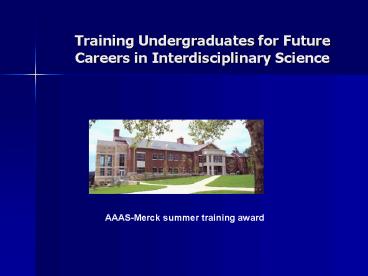Training Undergraduates for Future Careers in Interdisciplinary Science - PowerPoint PPT Presentation
1 / 18
Title:
Training Undergraduates for Future Careers in Interdisciplinary Science
Description:
IdeS: Candidate for Z-LVG-CHN2 Inhibition? IdeS: Group A streptococcal cysteine protease with the ... IdeS fails to cleave the synthetic substrate. Big Question ... – PowerPoint PPT presentation
Number of Views:57
Avg rating:3.0/5.0
Title: Training Undergraduates for Future Careers in Interdisciplinary Science
1
Training Undergraduates for Future Careers in
Interdisciplinary Science
AAAS-Merck summer training award
2
Participants
- Synthetic/organic chemistry
- Richard Hark
- David Reingold
- Wes Carroll (student)
- Molecular modeling
- Paul Schettler
- Jeff Wolbach
- Cathy Stenson
- Jonilyn Longenecker (student)
- Biochemistry/enzymology
- Ruth Reed
- Lorraine Mulfinger
- Microbiology/molecular biology
- Michael Boyle
- Jennifer Hess
- Cecelia Shertz (student)
3
Proposed Scientific focus
- Identification of the target and mode of action
of a tripeptide compound with selectivity
toxicity for group A streptococci.
4
Background
A cysteine protease inhibitor (Z-LVG-CHN2)
protected mice from S. pyogenes Bjorck et al.
Nature., 337385-386 Cysteine proteinases are
important not only in the intracellular
catabolism of peptides and proteins and in the
processing of prohormones and proenzymes, but
also in the penetration of normal human tissue by
malignant cells and possibly microorganisms,
including viruses. ... The cysteine proteinase
produced by group A streptococci was isolated and
found to be inhibited by Z-LVG-CHN2 moreover,
excess proteinase relieved the growth inhibition
caused by the peptide derivative, suggesting that
the antibacterial activity of Z-LVG-CHN2 is due
to inhibition of this cysteine proteinase.
5
Experimental Verification
SpeB inhibited by Z-LVG-CHN2 and E64
6
Confounding Issues with SpeB
BUT
7
Conclusion
- SpeB can not be the target of the anti-microbial
entity.
8
IdeS Candidate for Z-LVG-CHN2 Inhibition?
- IdeS Group A streptococcal cysteine protease
with the following properties - Only known substrate is IgG.
- Activity inhibited by CBZ-LVG-CHN2 but not by
E64. (mirrors anti-microbial properties) - X-ray crystal structure is available
- Gene encodes the active protein there is no
evidence for it being expressed as a zymogen.
9
IdeS activity vs. IgG
1 2 3 4
50000 100000
150000
Arbitrary Units
50000 100000
150000
Daltons
10
SpeB is Inhibited by Z-LVG-CHN2 and E64
IdeS fails to cleave the synthetic substrate
11
Big Question
Could IdeS be the anti-microbial target? If not
IdeS, what is the target? (Fishing
expedition?)
12
Avenues of Investigation
- Modeling studies on active site
- Potential for identification of unique inhibitors
- Development of synthetic substrate assay
- Identification of exosite and ligand required for
enzymatic activity.
13
Study Branches
- Modeling approaches
- Jeff Wolbach, Paul Schettler, Cathy Stenson
- Chemical synthesis approaches
- Richard Hark and David Reingold
- Biochemical approaches
- Ruth Reed and Lorraine Mulfinger
- Microbiological approaches
- Michael Boyle and Jennifer Hess
14
Molecular Modeling Capabilities
- Molecular Dynamics Simulations
- Characterization of active site
- Possibly investigate allosteric site
- Automated Docking
- Faster, but does not include solvent effects and
protein flexibility - AutoDock, Dock, Fred?
- Quantum or QM/MM calculations
- Gaussian03
15
Organic Synthesis Capabilities
- Conversion of acid groups into diazomethyl
ketones - Solid phase peptide synthesis (limited experience)
16
Biochemical Capabilities
- Protein purification, modification
- Enzyme study
- Assay development
- Kinetic studies (inhibition/inactivation)
17
Microbiological Capabilities
- Measurement of ID50
- Selection of antibiotic resistant organisms
- Cloning and sequencing of targeted genes
- Expression and characterization of recombinant
proteins - Limited genetic manipulation of bacterial genomes.
18
- Is there an underlying scientific question or
hypothesis?

